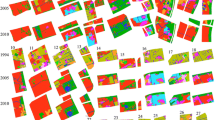Abstract
Until the early 1960s, Korea had no useful maps and adequate technical capacity to produce maps. This problem was overcome through the Joint Korea–Netherlands Aerial Photo Project (JKNP), and the outcome of JKNP became the basis of establishing Korea’s mapping system. Therefore, JKNP can be evaluated as successful. In this regard, this study derived the following success factors of JKNP: First, JKNP was implemented in a clear and direct demand-oriented manner. Second, the environment in which the JKNP implementation system could be well established and operated vertically and horizontally was created. Third, national technical capacity to produce maps independently was secured. Fourth, the national implementation system for future sustainable map production was established. JKNP helped to produce aerial photographs and topographic maps, which were used to implement various economic development projects. From the perspective of JKNP, all four factors contributed to a successful achievement of the objectives of JKNP. From a national perspective, the latter two factors became a basis for the establishment of a future mapping system and the emergence of the surveying industry. This helps to understand what should be emphasized to establish a sustainable development system in future. In particular, it has many implications for countries that do not have a geospatial information organization system.
Similar content being viewed by others
References
National Geographic Information Institute. (2003). Survey and Geospatial Information White Paper. South Korea.
Jung, J. G., Choi, J. W., Lee, S. W., Jung, J. G., & Jung, G. H. (2014). Theories of policy sciences. Seoul: Daemyung Publisher.
Ryu, J. S. (2008). Policy science. South Korea: Daeyoung Co.
Choi, J. W., & Bin, B. S. (2001). An analytical review of empirical studies on policy implementation in Korea. Korea Journal of Public Administration, 39(3), 167–196.
Sabatier, P. A., & Mazmanian, D. (1979). The conditions of effective implementation: Guide to accomplishing policy objectives. Policy Analysis, 5(4), 481.
Matland, R. E. (1995). Synthesizing the implementation literature: The ambiguity-conflict model of policy implementation. Journal of Public Administration Research and Theory: J-PART, 5(2), 145–174.
Executive Subcommittee. (1995). Master Plan of National Geographic Information System Construction Project, South Korea.
Hague Original Joint Statement, 1965.9.23. KASM. (2008). The history of aerial photogrammetry development (p. 15).
Choi, J. H. (2008). Study on the development of aerial photogrammetry in Korea, South Korea.
Nakamura, R., & Smallwood, F. (1980). The politics of policy implementation. New York: St. Martin’s Press.
National Archives of Korea. (2017).http://theme.archives.go.kr/next/gyeongbu/roadStatistics09.do, http://theme.archives.go.kr/next/koreaOfRecord/daedukResearch.do.,http://www.motie.go.kr/ftz/masan/freeTradeArea/aboutFreeTradeArea/aboutFreeTradeArea.jsp, https://ko.wikipedia.org/wiki/%EA%B5%AC%EB%AF%B8%EA%B5%AD%EA%B0%80%EC%82%B0%EC%97%85%EB%8B%A8%EC%A7%80. Accessed December 21, 2017.
Author information
Authors and Affiliations
Corresponding author
Rights and permissions
About this article
Cite this article
Choe, B., Joo, H. & Park, S. Exploring success factors of Joint Korea–Netherlands Aerial Photo Project. Spat. Inf. Res. 27, 217–226 (2019). https://doi.org/10.1007/s41324-018-0226-7
Received:
Revised:
Accepted:
Published:
Issue Date:
DOI: https://doi.org/10.1007/s41324-018-0226-7




